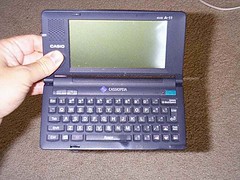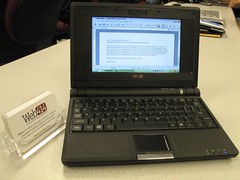
 Computer Notebook:
Why An EEEPC?
Computer Notebook:
Why An EEEPC?
This content is saved for historical purposes and is no longer updated.
I've always wanted to have a very mobile computer.
In exchange
for this portability,
I've been willing to sacrifice functionality.
So while many
laptop computers offer amazing computing power,
their size and bulk reduce their portability.
My goal for a mobile computer is
on a small size and weight, while still
having the capability to surf the Web
using WiFi networks and
use simple computer software
like text processing and
a media player.
In early 2008, I found that small computers that met my needs were coming onto the market.
I had a good desktop computer, so I could do most of my work with a bigger screen, large hard disk, and good computing power. I could run applications like Photoshop and others on my desktop computer. My needs were simple otherwise. I needed mobility more than power for a netbook PC.
How Did I Decide on the EEEPC?
I have long wanted a very small and mobile computer. Back in 1997, I bought a Casio Cassiopeia A-11, because it was small (17.3 cm x 2.5 cm x 9.1 cm) and light (380 g). It could exchange files with my PC easily and even had a spreadsheet application and word processing. It took AA batteries, so I could easily carry extras or buy new batteries anywhere. It had a slot for a Compact Flash card for extra memory. I could type very fast on its small keyboard, and I took this little computer on trips around the world because it could pack so easily--everywhere from NYC, to Hawaii, Hong Kong, London, Vienna, and more.
My Cassiopeia worked very well for several years, but then it gave out because it would not stay powered, and I judged the cost of repair exceeded its value. Handheld PDA's took the world by storm for the next several years, but I was always concerned about getting locked into proprietary batteries, parts, and operating systems. I did get a laptop (although I was not happy with how heavy it was), so I didn't feel the need for a more mobile computer for a while (the laptop eventually died after 6 years of intensive use). I did not buy another laptop for awhile. Laptop computers, rather than getting simpler and lighter over the years, bloated to gargantuan weights and sizes and were loaded with vast amounts of things I would never need, want, or use. I therefore held off buying any of them. I was very disappointed with computer makers who were unable to discern that a market exists for people who want simple, lightweight devices that actually work. (I still am disappointed by most computer makers who remain clueless about the vast market for small, lightweight, simple computers that work).
For a desktop computer, I had a HP Slimline computer which is smaller than standard desktop computers. My desktop PC has 2 GB of memory and a 2.40 GHz processor. I also like small keyboards--I use a Crystal Visions compact keyboard that has touchpad; it is like a keyboard for a laptop computer in size. My preference for smaller computers and smaller keyboards meant that I was very interested in a small mobile computer.
The prevalance of WiFi and my interest in flickr re-awakened my desire for a mobile computer that I might use outside to write, check email, surf the Web, and post photos around town rather than relying just on my home desktop computer. I was looking in late 2007 and by 2008, I was about ready to buy something.
At the January 2008 meeting of Web414, raster (Pete) demonstrated his EEEPC, and so I got a chance to try it out.
Pete's account was favorable, and I definitely liked the size and weight of the computer, so I ordered the 4 G model in February when once I saw the 8 G model would be delayed. No other manufacturer that I could find had a reasonably-priced small computer for sale under 1 kg.
Summary: Why Did I get an EEEPC?
- Weight (less than 1 kg). I can easily take it anywhere.
- Small size (22.6 cm x 16 cm x 2 cm). It fits in my backpack as easily as a book.
- Simple applications and operation. I want to focus on my work rather than spending time upgrading, adjusting, updating, tweaking, troubleshooting, reinstalling, and maintaining software to do simple tasks.
- WiFi capability. I can get online access as I go about town (at a cafe or at a meeting) or traveling.
- Extra computer. I can use the EEEPC as an alternate computer in case my main computer goes out.
| My Picks | |
|---|---|
|
This was released in 2011.
Weight: 0.92 kg Size: 26.2 x 18 x 1.76 cm This is an excellent choice for an EEEPC! Weighing less than 1 kg, it has an 8 GB SSD, 1 GB of RAM, and has a 25.6 cm display. This keeps the tradition of a small, compact, ultra-portable computer alive. It comes with a MeeGo operating system, but you could replace this with an operating system such as Linux Mint. |
This is the system that I bought in February 2008--it is no longer available.
Weight: 0.922 kg Size: 22.5 x 16 x 3.2 cm This is the EEEPC 4G computer that I own. |










